Assessment 2 Guided Review of nominated literature
VerifiedAdded on 2023/01/18
|13
|2625
|37
AI Summary
This document provides a guided review of nominated literature for Assessment 2. It includes qualitative and quantitative studies, aims, methods, data analysis, findings, limitations, and recommendations. The study focuses on exploring the experiences of nurses with their workplace relationship and support in relation to safe medication practices. The findings highlight the importance of workplace support in improving medication safety. The document also discusses the limitations of the study and provides recommendations for future research.
Contribute Materials
Your contribution can guide someone’s learning journey. Share your
documents today.
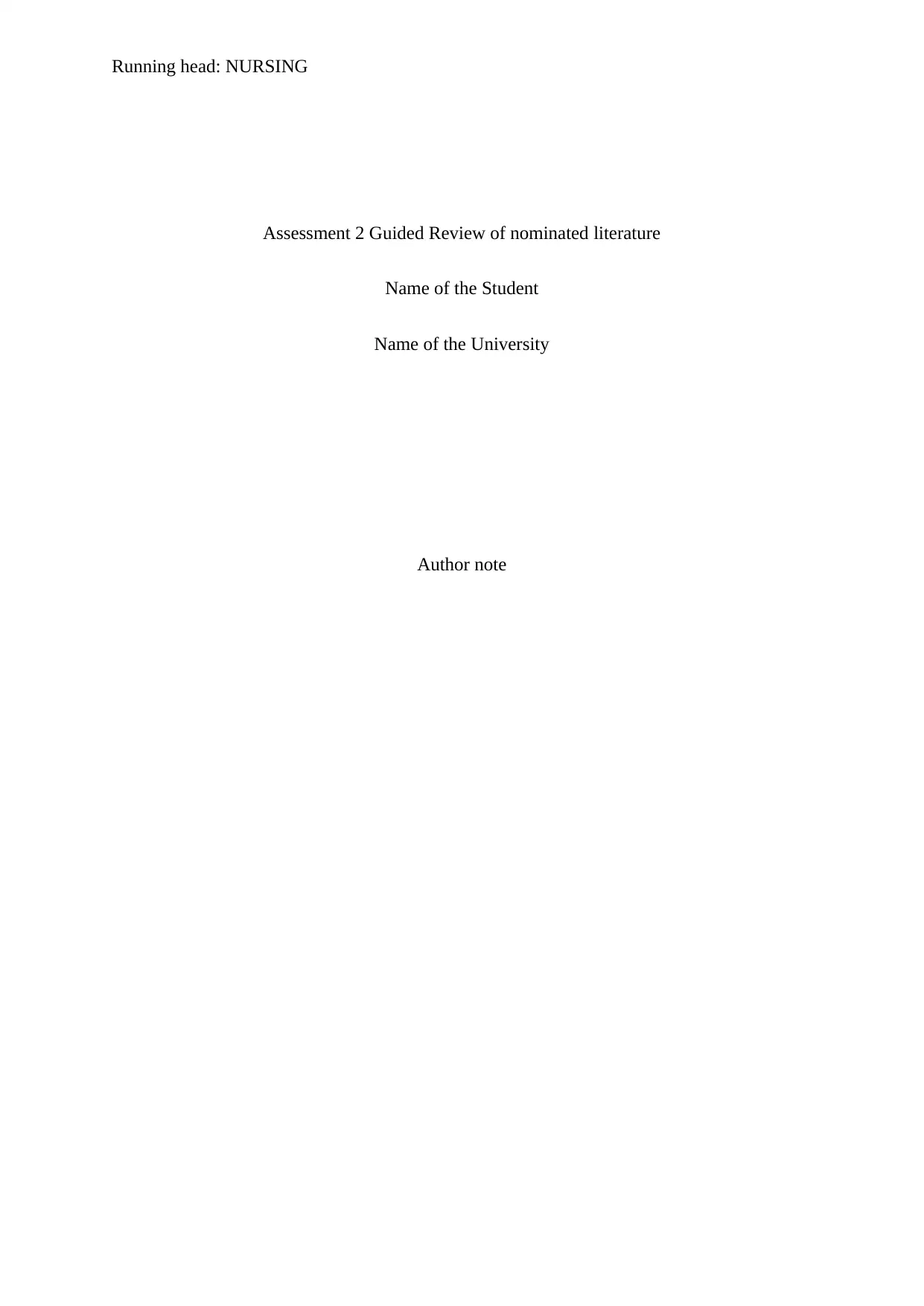
Running head: NURSING
Assessment 2 Guided Review of nominated literature
Name of the Student
Name of the University
Author note
Assessment 2 Guided Review of nominated literature
Name of the Student
Name of the University
Author note
Secure Best Marks with AI Grader
Need help grading? Try our AI Grader for instant feedback on your assignments.

1NURSING
Template for comparison
Guided Question Qualitative Study Quantitative Study
1. Aim and
Significance
(5 marks 200
words)
a. What was the
aim and
significance of
the study?
The aim of the study was to
explore the experiences of
nurses with, and their
viewpoints on prevention of
medication errors caused due
to administration (Smeulers,
Onderwater, van Zwieten &
Vermeulen, 2014).
The aim of the study was
significant owing to the fact
that medication errors have
been identified as one of the
most prevalent types of errors
that are associated with a
violation of patient health and
safety. Medications are the
common interventions that are
applied in healthcare settings,
all across the world and when
The aim of the study was to
investigate the correlation between
workplace relationship and support
and practices related to safe
medication among graduate nursing
professionals (Sahay, Hutchinson &
East, 2015).
The objective of the study was
significant owing to the fact that the
researchers identified the importance
of clinical confidence and critical
thinking ability among nurses, in
improving their performance. The
researchers addressed a well-focused
issue owing to the fact that any breach
in medication safety often results in
medication errors that lead to the
manifestation of adverse drug events
and directly threaten the health and
Template for comparison
Guided Question Qualitative Study Quantitative Study
1. Aim and
Significance
(5 marks 200
words)
a. What was the
aim and
significance of
the study?
The aim of the study was to
explore the experiences of
nurses with, and their
viewpoints on prevention of
medication errors caused due
to administration (Smeulers,
Onderwater, van Zwieten &
Vermeulen, 2014).
The aim of the study was
significant owing to the fact
that medication errors have
been identified as one of the
most prevalent types of errors
that are associated with a
violation of patient health and
safety. Medications are the
common interventions that are
applied in healthcare settings,
all across the world and when
The aim of the study was to
investigate the correlation between
workplace relationship and support
and practices related to safe
medication among graduate nursing
professionals (Sahay, Hutchinson &
East, 2015).
The objective of the study was
significant owing to the fact that the
researchers identified the importance
of clinical confidence and critical
thinking ability among nurses, in
improving their performance. The
researchers addressed a well-focused
issue owing to the fact that any breach
in medication safety often results in
medication errors that lead to the
manifestation of adverse drug events
and directly threaten the health and

2NURSING
implemented in an
appropriate manner, they
contribute to noteworthy
improvements in the
wellbeing and health of all
patients (Donaldson, Kelley,
Dhingra-Kumar, Kieny &
Sheikh, 2017). Thus,
conducting a study on
medication error was
significant as the findings
would help in improving
patient outcomes.
safety of the patients (Wittich, Burkle
& Lanier, 2014). In addition,
medication errors have been found to
increase at an alarming rate and
negligence or inattentiveness by
nurses can be accredited as a major
factor that contributes to such
circumstances.
2. Methods (10
marks 700
words)
a. Identify the
research design
used
in the study and
was
it appropriate for
the
issue discussed?
The researchers adopted a
qualitative research approach
for the investigation. The
scientific research approach
encompasses the collection of
non-numerical information
and also helps in obtaining
explanations in the form of
definitions, concepts, and
The researchers adopted a quantitative
research approach for their
investigation. Quantitative research
involves the empirical investigation of
several phenomena that are
observable, through the adoption of
mathematical, statistical and
computational procedures. Owing to
the fact that the researchers aimed to
implemented in an
appropriate manner, they
contribute to noteworthy
improvements in the
wellbeing and health of all
patients (Donaldson, Kelley,
Dhingra-Kumar, Kieny &
Sheikh, 2017). Thus,
conducting a study on
medication error was
significant as the findings
would help in improving
patient outcomes.
safety of the patients (Wittich, Burkle
& Lanier, 2014). In addition,
medication errors have been found to
increase at an alarming rate and
negligence or inattentiveness by
nurses can be accredited as a major
factor that contributes to such
circumstances.
2. Methods (10
marks 700
words)
a. Identify the
research design
used
in the study and
was
it appropriate for
the
issue discussed?
The researchers adopted a
qualitative research approach
for the investigation. The
scientific research approach
encompasses the collection of
non-numerical information
and also helps in obtaining
explanations in the form of
definitions, concepts, and
The researchers adopted a quantitative
research approach for their
investigation. Quantitative research
involves the empirical investigation of
several phenomena that are
observable, through the adoption of
mathematical, statistical and
computational procedures. Owing to
the fact that the researchers aimed to
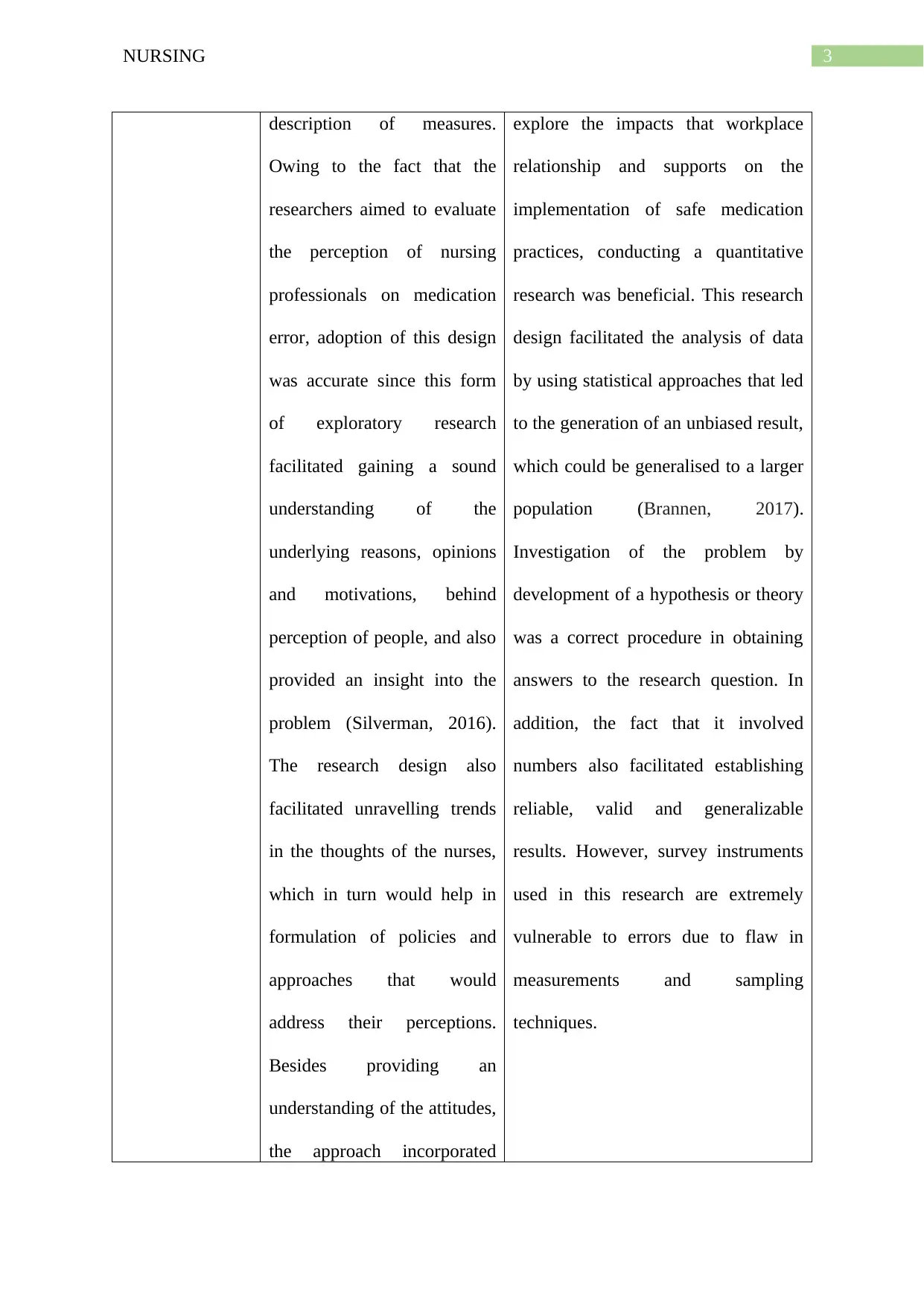
3NURSING
description of measures.
Owing to the fact that the
researchers aimed to evaluate
the perception of nursing
professionals on medication
error, adoption of this design
was accurate since this form
of exploratory research
facilitated gaining a sound
understanding of the
underlying reasons, opinions
and motivations, behind
perception of people, and also
provided an insight into the
problem (Silverman, 2016).
The research design also
facilitated unravelling trends
in the thoughts of the nurses,
which in turn would help in
formulation of policies and
approaches that would
address their perceptions.
Besides providing an
understanding of the attitudes,
the approach incorporated
explore the impacts that workplace
relationship and supports on the
implementation of safe medication
practices, conducting a quantitative
research was beneficial. This research
design facilitated the analysis of data
by using statistical approaches that led
to the generation of an unbiased result,
which could be generalised to a larger
population (Brannen, 2017).
Investigation of the problem by
development of a hypothesis or theory
was a correct procedure in obtaining
answers to the research question. In
addition, the fact that it involved
numbers also facilitated establishing
reliable, valid and generalizable
results. However, survey instruments
used in this research are extremely
vulnerable to errors due to flaw in
measurements and sampling
techniques.
description of measures.
Owing to the fact that the
researchers aimed to evaluate
the perception of nursing
professionals on medication
error, adoption of this design
was accurate since this form
of exploratory research
facilitated gaining a sound
understanding of the
underlying reasons, opinions
and motivations, behind
perception of people, and also
provided an insight into the
problem (Silverman, 2016).
The research design also
facilitated unravelling trends
in the thoughts of the nurses,
which in turn would help in
formulation of policies and
approaches that would
address their perceptions.
Besides providing an
understanding of the attitudes,
the approach incorporated
explore the impacts that workplace
relationship and supports on the
implementation of safe medication
practices, conducting a quantitative
research was beneficial. This research
design facilitated the analysis of data
by using statistical approaches that led
to the generation of an unbiased result,
which could be generalised to a larger
population (Brannen, 2017).
Investigation of the problem by
development of a hypothesis or theory
was a correct procedure in obtaining
answers to the research question. In
addition, the fact that it involved
numbers also facilitated establishing
reliable, valid and generalizable
results. However, survey instruments
used in this research are extremely
vulnerable to errors due to flaw in
measurements and sampling
techniques.
Secure Best Marks with AI Grader
Need help grading? Try our AI Grader for instant feedback on your assignments.
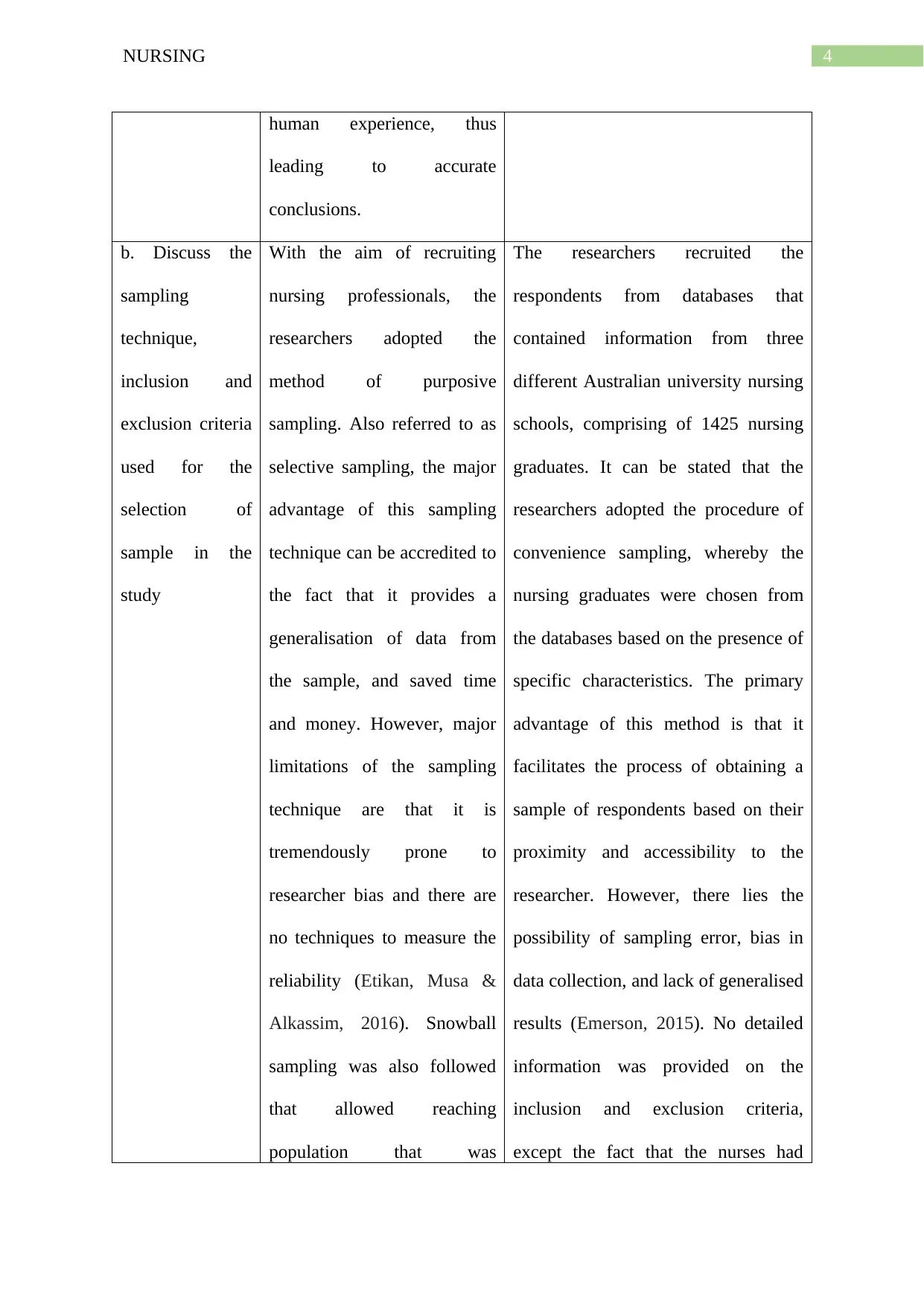
4NURSING
human experience, thus
leading to accurate
conclusions.
b. Discuss the
sampling
technique,
inclusion and
exclusion criteria
used for the
selection of
sample in the
study
With the aim of recruiting
nursing professionals, the
researchers adopted the
method of purposive
sampling. Also referred to as
selective sampling, the major
advantage of this sampling
technique can be accredited to
the fact that it provides a
generalisation of data from
the sample, and saved time
and money. However, major
limitations of the sampling
technique are that it is
tremendously prone to
researcher bias and there are
no techniques to measure the
reliability (Etikan, Musa &
Alkassim, 2016). Snowball
sampling was also followed
that allowed reaching
population that was
The researchers recruited the
respondents from databases that
contained information from three
different Australian university nursing
schools, comprising of 1425 nursing
graduates. It can be stated that the
researchers adopted the procedure of
convenience sampling, whereby the
nursing graduates were chosen from
the databases based on the presence of
specific characteristics. The primary
advantage of this method is that it
facilitates the process of obtaining a
sample of respondents based on their
proximity and accessibility to the
researcher. However, there lies the
possibility of sampling error, bias in
data collection, and lack of generalised
results (Emerson, 2015). No detailed
information was provided on the
inclusion and exclusion criteria,
except the fact that the nurses had
human experience, thus
leading to accurate
conclusions.
b. Discuss the
sampling
technique,
inclusion and
exclusion criteria
used for the
selection of
sample in the
study
With the aim of recruiting
nursing professionals, the
researchers adopted the
method of purposive
sampling. Also referred to as
selective sampling, the major
advantage of this sampling
technique can be accredited to
the fact that it provides a
generalisation of data from
the sample, and saved time
and money. However, major
limitations of the sampling
technique are that it is
tremendously prone to
researcher bias and there are
no techniques to measure the
reliability (Etikan, Musa &
Alkassim, 2016). Snowball
sampling was also followed
that allowed reaching
population that was
The researchers recruited the
respondents from databases that
contained information from three
different Australian university nursing
schools, comprising of 1425 nursing
graduates. It can be stated that the
researchers adopted the procedure of
convenience sampling, whereby the
nursing graduates were chosen from
the databases based on the presence of
specific characteristics. The primary
advantage of this method is that it
facilitates the process of obtaining a
sample of respondents based on their
proximity and accessibility to the
researcher. However, there lies the
possibility of sampling error, bias in
data collection, and lack of generalised
results (Emerson, 2015). No detailed
information was provided on the
inclusion and exclusion criteria,
except the fact that the nurses had
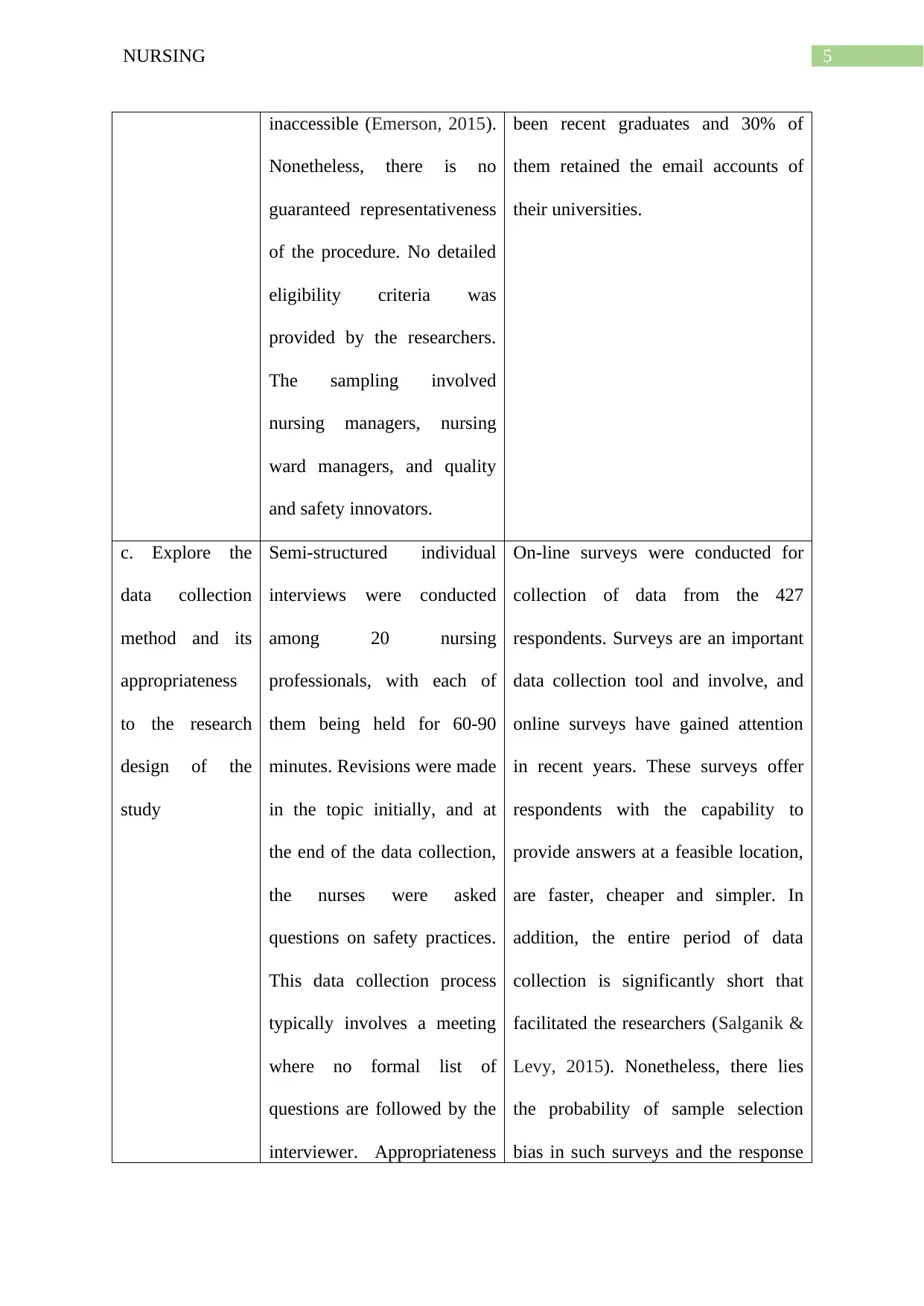
5NURSING
inaccessible (Emerson, 2015).
Nonetheless, there is no
guaranteed representativeness
of the procedure. No detailed
eligibility criteria was
provided by the researchers.
The sampling involved
nursing managers, nursing
ward managers, and quality
and safety innovators.
been recent graduates and 30% of
them retained the email accounts of
their universities.
c. Explore the
data collection
method and its
appropriateness
to the research
design of the
study
Semi-structured individual
interviews were conducted
among 20 nursing
professionals, with each of
them being held for 60-90
minutes. Revisions were made
in the topic initially, and at
the end of the data collection,
the nurses were asked
questions on safety practices.
This data collection process
typically involves a meeting
where no formal list of
questions are followed by the
interviewer. Appropriateness
On-line surveys were conducted for
collection of data from the 427
respondents. Surveys are an important
data collection tool and involve, and
online surveys have gained attention
in recent years. These surveys offer
respondents with the capability to
provide answers at a feasible location,
are faster, cheaper and simpler. In
addition, the entire period of data
collection is significantly short that
facilitated the researchers (Salganik &
Levy, 2015). Nonetheless, there lies
the probability of sample selection
bias in such surveys and the response
inaccessible (Emerson, 2015).
Nonetheless, there is no
guaranteed representativeness
of the procedure. No detailed
eligibility criteria was
provided by the researchers.
The sampling involved
nursing managers, nursing
ward managers, and quality
and safety innovators.
been recent graduates and 30% of
them retained the email accounts of
their universities.
c. Explore the
data collection
method and its
appropriateness
to the research
design of the
study
Semi-structured individual
interviews were conducted
among 20 nursing
professionals, with each of
them being held for 60-90
minutes. Revisions were made
in the topic initially, and at
the end of the data collection,
the nurses were asked
questions on safety practices.
This data collection process
typically involves a meeting
where no formal list of
questions are followed by the
interviewer. Appropriateness
On-line surveys were conducted for
collection of data from the 427
respondents. Surveys are an important
data collection tool and involve, and
online surveys have gained attention
in recent years. These surveys offer
respondents with the capability to
provide answers at a feasible location,
are faster, cheaper and simpler. In
addition, the entire period of data
collection is significantly short that
facilitated the researchers (Salganik &
Levy, 2015). Nonetheless, there lies
the probability of sample selection
bias in such surveys and the response
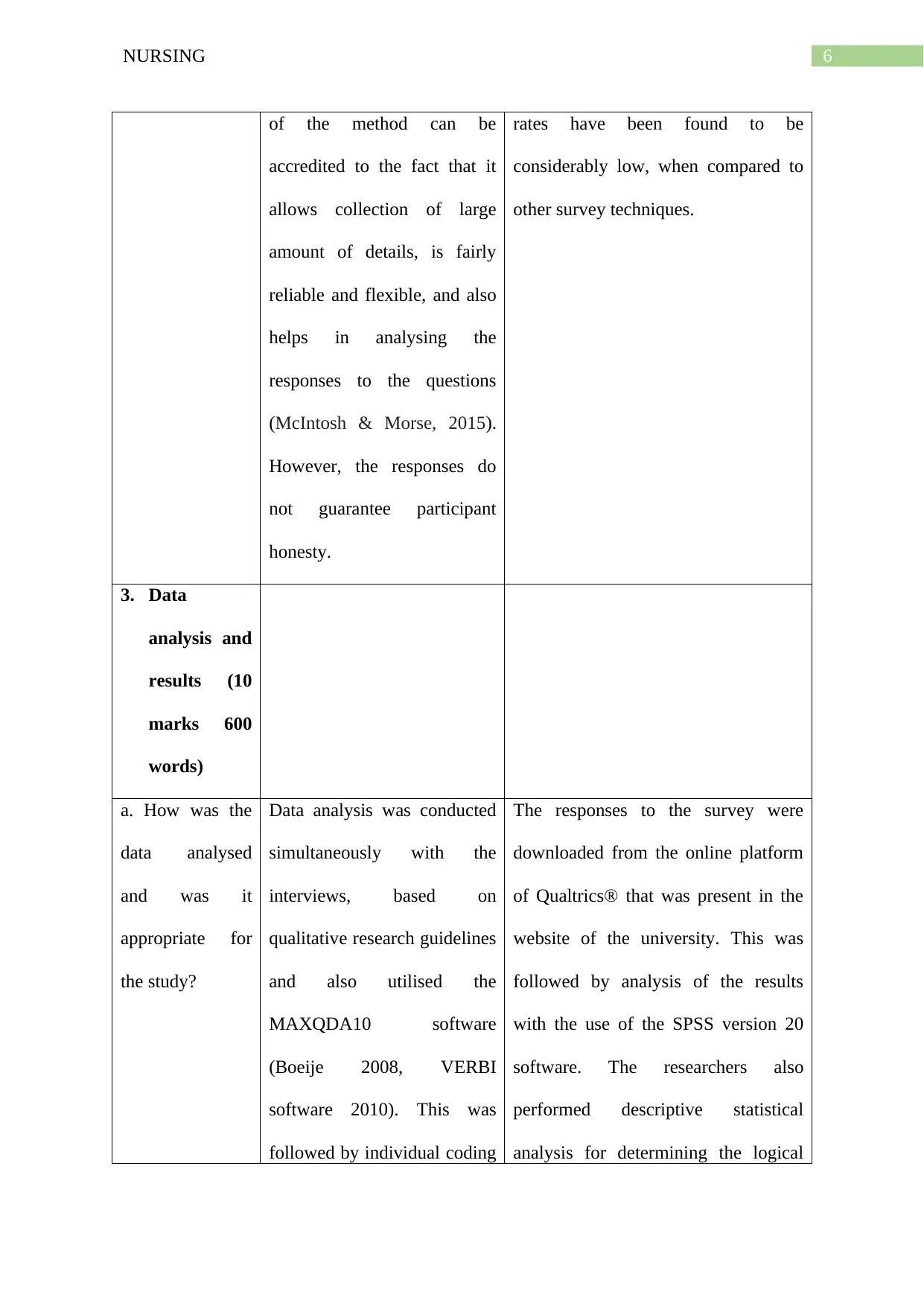
6NURSING
of the method can be
accredited to the fact that it
allows collection of large
amount of details, is fairly
reliable and flexible, and also
helps in analysing the
responses to the questions
(McIntosh & Morse, 2015).
However, the responses do
not guarantee participant
honesty.
rates have been found to be
considerably low, when compared to
other survey techniques.
3. Data
analysis and
results (10
marks 600
words)
a. How was the
data analysed
and was it
appropriate for
the study?
Data analysis was conducted
simultaneously with the
interviews, based on
qualitative research guidelines
and also utilised the
MAXQDA10 software
(Boeije 2008, VERBI
software 2010). This was
followed by individual coding
The responses to the survey were
downloaded from the online platform
of Qualtrics® that was present in the
website of the university. This was
followed by analysis of the results
with the use of the SPSS version 20
software. The researchers also
performed descriptive statistical
analysis for determining the logical
of the method can be
accredited to the fact that it
allows collection of large
amount of details, is fairly
reliable and flexible, and also
helps in analysing the
responses to the questions
(McIntosh & Morse, 2015).
However, the responses do
not guarantee participant
honesty.
rates have been found to be
considerably low, when compared to
other survey techniques.
3. Data
analysis and
results (10
marks 600
words)
a. How was the
data analysed
and was it
appropriate for
the study?
Data analysis was conducted
simultaneously with the
interviews, based on
qualitative research guidelines
and also utilised the
MAXQDA10 software
(Boeije 2008, VERBI
software 2010). This was
followed by individual coding
The responses to the survey were
downloaded from the online platform
of Qualtrics® that was present in the
website of the university. This was
followed by analysis of the results
with the use of the SPSS version 20
software. The researchers also
performed descriptive statistical
analysis for determining the logical
Paraphrase This Document
Need a fresh take? Get an instant paraphrase of this document with our AI Paraphraser

7NURSING
of the interview responses,
after which all the codes were
separately compared and
analysed until reaching a
consensus for the coding tree.
Consensus meetings helped in
identifying the most recurrent
and relevant themes that
focused on the perceptions
and perspectives of nurses on
medication safety. Hence,
thematic analysis of the
responses was a correct
approach since it
encompassed the
identification, examination
and documentation of
information within data, thus
fulfilling the objectives of the
qualitative research (Braun,
Clarke, Hayfield & Terry,
2019). In addition, use of the
MAXQDA10 software was
another correct approach
since this software program
responses, in addition to recognising
the extent of data that was missing.
Use of the SPSS tool was a correct
approach since it is a widely popular
software for statistical analysis that is
primarily used in social research. In
addition, the software also facilitates
data management and data
documentation that assisted the
researchers during the quantitative
research (West, Welch & Galecki,
2014). Conducting a descriptive
statistics was another accurate
procedure since the coefficients
obtained summarised the data set and
acted as a representation of the general
sample of the nursing population, by
breaking them down into measures of
variability and central tendency.
of the interview responses,
after which all the codes were
separately compared and
analysed until reaching a
consensus for the coding tree.
Consensus meetings helped in
identifying the most recurrent
and relevant themes that
focused on the perceptions
and perspectives of nurses on
medication safety. Hence,
thematic analysis of the
responses was a correct
approach since it
encompassed the
identification, examination
and documentation of
information within data, thus
fulfilling the objectives of the
qualitative research (Braun,
Clarke, Hayfield & Terry,
2019). In addition, use of the
MAXQDA10 software was
another correct approach
since this software program
responses, in addition to recognising
the extent of data that was missing.
Use of the SPSS tool was a correct
approach since it is a widely popular
software for statistical analysis that is
primarily used in social research. In
addition, the software also facilitates
data management and data
documentation that assisted the
researchers during the quantitative
research (West, Welch & Galecki,
2014). Conducting a descriptive
statistics was another accurate
procedure since the coefficients
obtained summarised the data set and
acted as a representation of the general
sample of the nursing population, by
breaking them down into measures of
variability and central tendency.
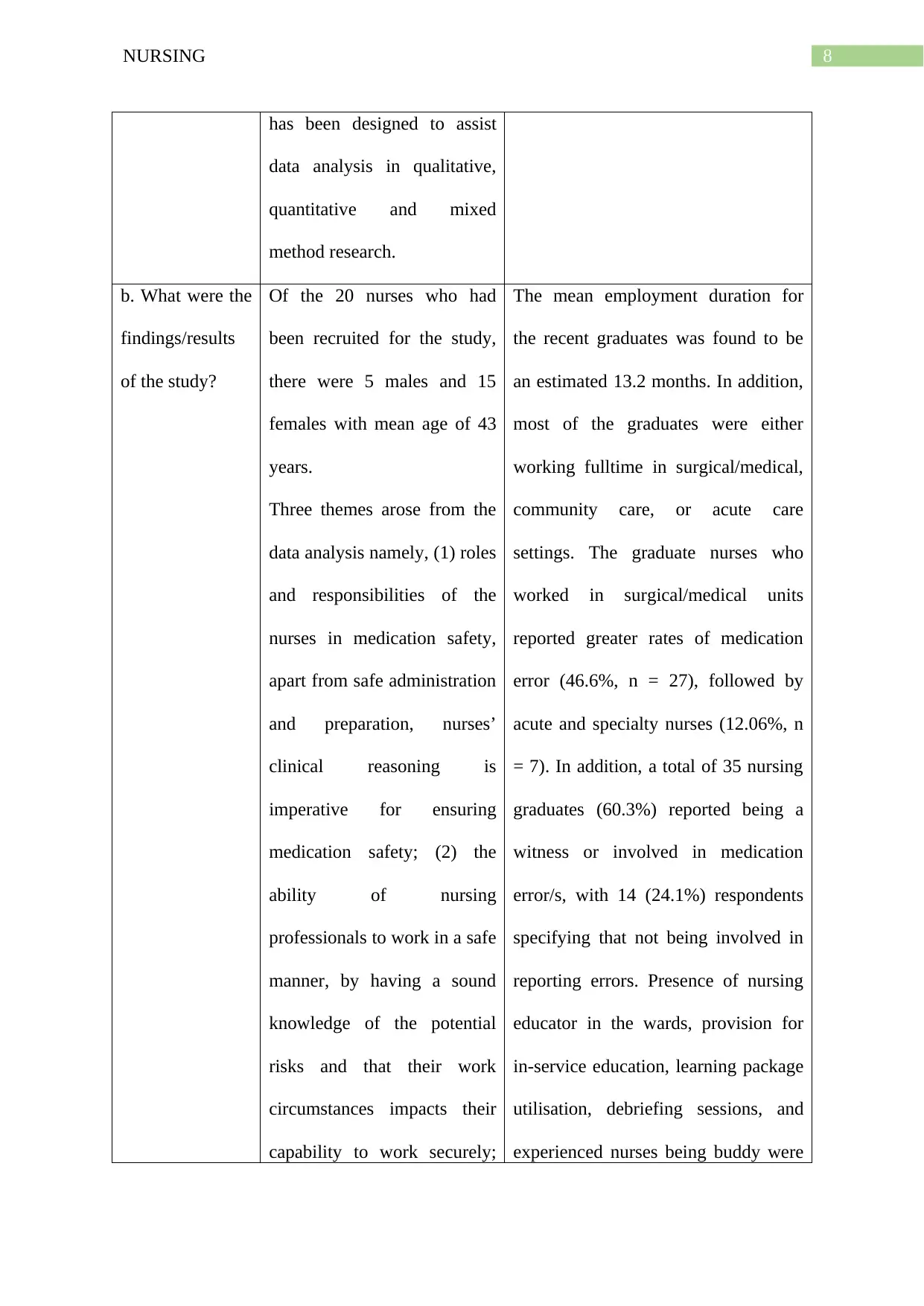
8NURSING
has been designed to assist
data analysis in qualitative,
quantitative and mixed
method research.
b. What were the
findings/results
of the study?
Of the 20 nurses who had
been recruited for the study,
there were 5 males and 15
females with mean age of 43
years.
Three themes arose from the
data analysis namely, (1) roles
and responsibilities of the
nurses in medication safety,
apart from safe administration
and preparation, nurses’
clinical reasoning is
imperative for ensuring
medication safety; (2) the
ability of nursing
professionals to work in a safe
manner, by having a sound
knowledge of the potential
risks and that their work
circumstances impacts their
capability to work securely;
The mean employment duration for
the recent graduates was found to be
an estimated 13.2 months. In addition,
most of the graduates were either
working fulltime in surgical/medical,
community care, or acute care
settings. The graduate nurses who
worked in surgical/medical units
reported greater rates of medication
error (46.6%, n = 27), followed by
acute and specialty nurses (12.06%, n
= 7). In addition, a total of 35 nursing
graduates (60.3%) reported being a
witness or involved in medication
error/s, with 14 (24.1%) respondents
specifying that not being involved in
reporting errors. Presence of nursing
educator in the wards, provision for
in-service education, learning package
utilisation, debriefing sessions, and
experienced nurses being buddy were
has been designed to assist
data analysis in qualitative,
quantitative and mixed
method research.
b. What were the
findings/results
of the study?
Of the 20 nurses who had
been recruited for the study,
there were 5 males and 15
females with mean age of 43
years.
Three themes arose from the
data analysis namely, (1) roles
and responsibilities of the
nurses in medication safety,
apart from safe administration
and preparation, nurses’
clinical reasoning is
imperative for ensuring
medication safety; (2) the
ability of nursing
professionals to work in a safe
manner, by having a sound
knowledge of the potential
risks and that their work
circumstances impacts their
capability to work securely;
The mean employment duration for
the recent graduates was found to be
an estimated 13.2 months. In addition,
most of the graduates were either
working fulltime in surgical/medical,
community care, or acute care
settings. The graduate nurses who
worked in surgical/medical units
reported greater rates of medication
error (46.6%, n = 27), followed by
acute and specialty nurses (12.06%, n
= 7). In addition, a total of 35 nursing
graduates (60.3%) reported being a
witness or involved in medication
error/s, with 14 (24.1%) respondents
specifying that not being involved in
reporting errors. Presence of nursing
educator in the wards, provision for
in-service education, learning package
utilisation, debriefing sessions, and
experienced nurses being buddy were
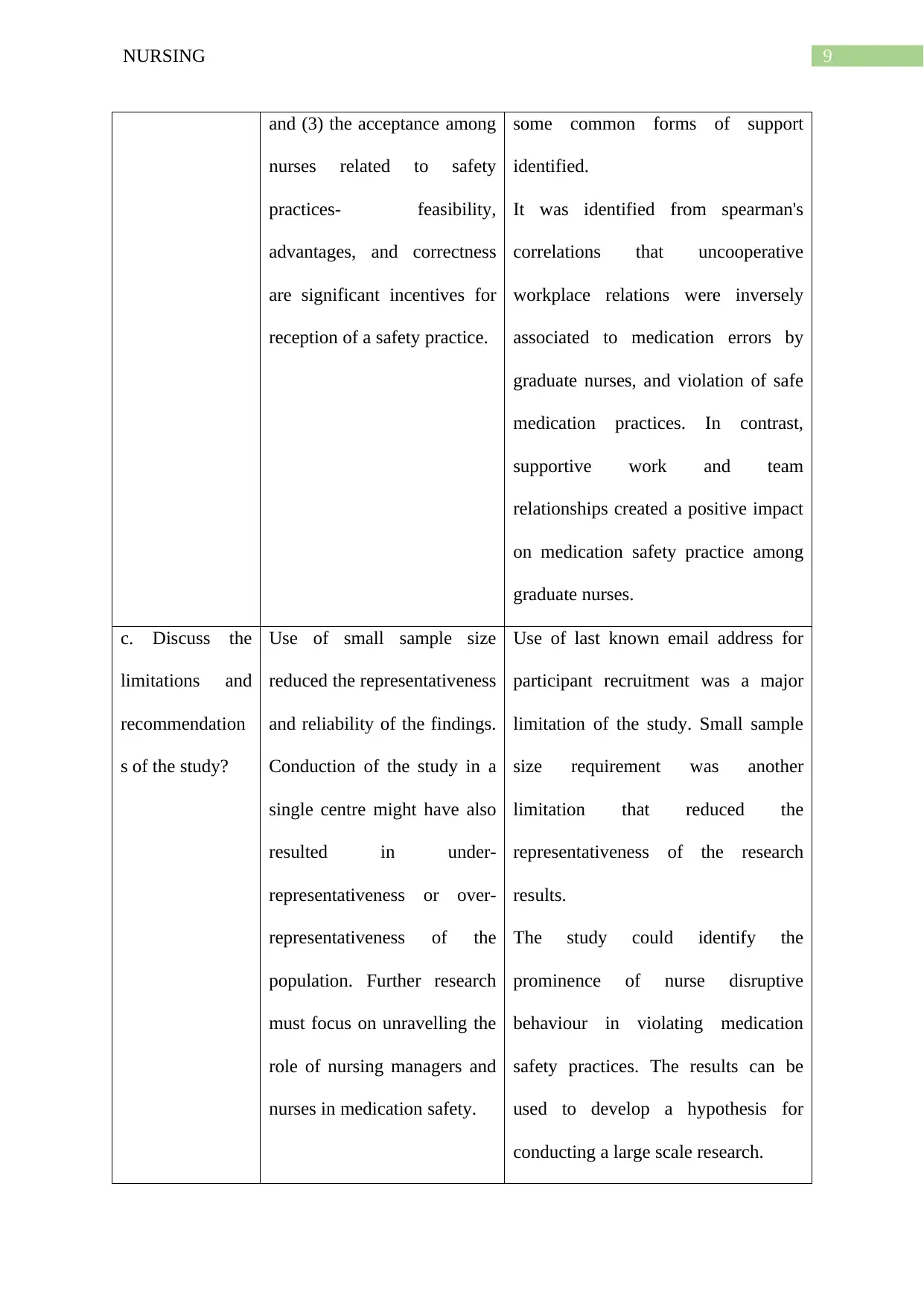
9NURSING
and (3) the acceptance among
nurses related to safety
practices- feasibility,
advantages, and correctness
are significant incentives for
reception of a safety practice.
some common forms of support
identified.
It was identified from spearman's
correlations that uncooperative
workplace relations were inversely
associated to medication errors by
graduate nurses, and violation of safe
medication practices. In contrast,
supportive work and team
relationships created a positive impact
on medication safety practice among
graduate nurses.
c. Discuss the
limitations and
recommendation
s of the study?
Use of small sample size
reduced the representativeness
and reliability of the findings.
Conduction of the study in a
single centre might have also
resulted in under-
representativeness or over-
representativeness of the
population. Further research
must focus on unravelling the
role of nursing managers and
nurses in medication safety.
Use of last known email address for
participant recruitment was a major
limitation of the study. Small sample
size requirement was another
limitation that reduced the
representativeness of the research
results.
The study could identify the
prominence of nurse disruptive
behaviour in violating medication
safety practices. The results can be
used to develop a hypothesis for
conducting a large scale research.
and (3) the acceptance among
nurses related to safety
practices- feasibility,
advantages, and correctness
are significant incentives for
reception of a safety practice.
some common forms of support
identified.
It was identified from spearman's
correlations that uncooperative
workplace relations were inversely
associated to medication errors by
graduate nurses, and violation of safe
medication practices. In contrast,
supportive work and team
relationships created a positive impact
on medication safety practice among
graduate nurses.
c. Discuss the
limitations and
recommendation
s of the study?
Use of small sample size
reduced the representativeness
and reliability of the findings.
Conduction of the study in a
single centre might have also
resulted in under-
representativeness or over-
representativeness of the
population. Further research
must focus on unravelling the
role of nursing managers and
nurses in medication safety.
Use of last known email address for
participant recruitment was a major
limitation of the study. Small sample
size requirement was another
limitation that reduced the
representativeness of the research
results.
The study could identify the
prominence of nurse disruptive
behaviour in violating medication
safety practices. The results can be
used to develop a hypothesis for
conducting a large scale research.
Secure Best Marks with AI Grader
Need help grading? Try our AI Grader for instant feedback on your assignments.

10NURSING

11NURSING
References
Brannen, J. (2017). Mixing methods: Qualitative and quantitative research. Routledge.
https://doi.org/10.4324/9781315248813
Braun, V., Clarke, V., Hayfield, N., & Terry, G. (2019). Thematic analysis. Handbook of
Research Methods in Health Social Sciences, 843-860. https://doi.org/10.1007/978-
981-10-5251-4_103
Donaldson, L. J., Kelley, E. T., Dhingra-Kumar, N., Kieny, M. P., & Sheikh, A. (2017).
Medication without harm: who's third global patient safety challenge. The
Lancet, 389(10080), 1680-1681. https://doi.org/10.1016/S0140-6736(17)31047-4
Emerson, R. W. (2015). Convenience sampling, random sampling, and snowball sampling:
How does sampling affect the validity of research?. Journal of Visual Impairment &
Blindness, 109(2), 164-168. https://doi.org/10.1177%2F0145482X1510900215
Etikan, I., Musa, S. A., & Alkassim, R. S. (2016). Comparison of convenience sampling and
purposive sampling. American journal of theoretical and applied statistics, 5(1), 1-4.
https://www.researchgate.net/publication/304339244_Comparison_of_Convenience_
Sampling_and_Purposive_Sampling?enrichId=rgreq-
bf5b0eb8e8f469cc5c068fabc91c640e-
XXX&enrichSource=Y292ZXJQYWdlOzMwNDMzOTI0NDtBUzo0NjAxNTcxOD
U0NjYzNjlAMTQ4NjcyMTQzMDYxNQ%3D
%3D&el=1_x_2&_esc=publicationCoverPdf
McIntosh, M. J., & Morse, J. M. (2015). Situating and constructing diversity in semi-
structured interviews. Global qualitative nursing research, 2, 2333393615597674.
https://doi.org/10.1177%2F2333393615597674
References
Brannen, J. (2017). Mixing methods: Qualitative and quantitative research. Routledge.
https://doi.org/10.4324/9781315248813
Braun, V., Clarke, V., Hayfield, N., & Terry, G. (2019). Thematic analysis. Handbook of
Research Methods in Health Social Sciences, 843-860. https://doi.org/10.1007/978-
981-10-5251-4_103
Donaldson, L. J., Kelley, E. T., Dhingra-Kumar, N., Kieny, M. P., & Sheikh, A. (2017).
Medication without harm: who's third global patient safety challenge. The
Lancet, 389(10080), 1680-1681. https://doi.org/10.1016/S0140-6736(17)31047-4
Emerson, R. W. (2015). Convenience sampling, random sampling, and snowball sampling:
How does sampling affect the validity of research?. Journal of Visual Impairment &
Blindness, 109(2), 164-168. https://doi.org/10.1177%2F0145482X1510900215
Etikan, I., Musa, S. A., & Alkassim, R. S. (2016). Comparison of convenience sampling and
purposive sampling. American journal of theoretical and applied statistics, 5(1), 1-4.
https://www.researchgate.net/publication/304339244_Comparison_of_Convenience_
Sampling_and_Purposive_Sampling?enrichId=rgreq-
bf5b0eb8e8f469cc5c068fabc91c640e-
XXX&enrichSource=Y292ZXJQYWdlOzMwNDMzOTI0NDtBUzo0NjAxNTcxOD
U0NjYzNjlAMTQ4NjcyMTQzMDYxNQ%3D
%3D&el=1_x_2&_esc=publicationCoverPdf
McIntosh, M. J., & Morse, J. M. (2015). Situating and constructing diversity in semi-
structured interviews. Global qualitative nursing research, 2, 2333393615597674.
https://doi.org/10.1177%2F2333393615597674

12NURSING
Sahay, A., Hutchinson, M., & East, L. (2015). Exploring the influence of workplace supports
and relationships on safe medication practice: A pilot study of Australian graduate
nurses. Nurse education today, 35(5), e21-e26.
https://doi.org/10.1016/j.nedt.2015.01.012
Salganik, M. J., & Levy, K. E. (2015). Wiki surveys: Open and quantifiable social data
collection. PloS one, 10(5), e0123483. https://doi.org/10.1371/journal.pone.0123483
Silverman, D. (Ed.). (2016). Qualitative research. Sage. Retrieved from
https://books.google.co.in/books?
hl=en&lr=&id=9FALDAAAQBAJ&oi=fnd&pg=PP1&dq=qualitative+research&ots=
9ncCmz8w6J&sig=-4CDBCgFBOUT8ItiNqu-uoURxaE#v=onepage&q=qualitative
%20research&f=false
Smeulers, M., Onderwater, A. T., van Zwieten, M. C., & Vermeulen, H. (2014). Nurses'
experiences and perspectives on medication safety practices: an explorative
qualitative study. Journal of Nursing Management, 22(3), 276-285.
https://doi.org/10.1111/jonm.12225
West, B. T., Welch, K. B., & Galecki, A. T. (2014). Linear mixed models: a practical guide
using statistical software. Chapman and Hall/CRC. https://doi.org/10.1201/b17198
Wittich, C. M., Burkle, C. M., & Lanier, W. L. (2014, August). Medication errors: an
overview for clinicians. In Mayo Clinic Proceedings (Vol. 89, No. 8, pp. 1116-1125).
Elsevier. https://doi.org/10.1016/j.mayocp.2014.05.007
Sahay, A., Hutchinson, M., & East, L. (2015). Exploring the influence of workplace supports
and relationships on safe medication practice: A pilot study of Australian graduate
nurses. Nurse education today, 35(5), e21-e26.
https://doi.org/10.1016/j.nedt.2015.01.012
Salganik, M. J., & Levy, K. E. (2015). Wiki surveys: Open and quantifiable social data
collection. PloS one, 10(5), e0123483. https://doi.org/10.1371/journal.pone.0123483
Silverman, D. (Ed.). (2016). Qualitative research. Sage. Retrieved from
https://books.google.co.in/books?
hl=en&lr=&id=9FALDAAAQBAJ&oi=fnd&pg=PP1&dq=qualitative+research&ots=
9ncCmz8w6J&sig=-4CDBCgFBOUT8ItiNqu-uoURxaE#v=onepage&q=qualitative
%20research&f=false
Smeulers, M., Onderwater, A. T., van Zwieten, M. C., & Vermeulen, H. (2014). Nurses'
experiences and perspectives on medication safety practices: an explorative
qualitative study. Journal of Nursing Management, 22(3), 276-285.
https://doi.org/10.1111/jonm.12225
West, B. T., Welch, K. B., & Galecki, A. T. (2014). Linear mixed models: a practical guide
using statistical software. Chapman and Hall/CRC. https://doi.org/10.1201/b17198
Wittich, C. M., Burkle, C. M., & Lanier, W. L. (2014, August). Medication errors: an
overview for clinicians. In Mayo Clinic Proceedings (Vol. 89, No. 8, pp. 1116-1125).
Elsevier. https://doi.org/10.1016/j.mayocp.2014.05.007
1 out of 13
Related Documents
Your All-in-One AI-Powered Toolkit for Academic Success.
+13062052269
info@desklib.com
Available 24*7 on WhatsApp / Email
![[object Object]](/_next/static/media/star-bottom.7253800d.svg)
Unlock your academic potential
© 2024 | Zucol Services PVT LTD | All rights reserved.





